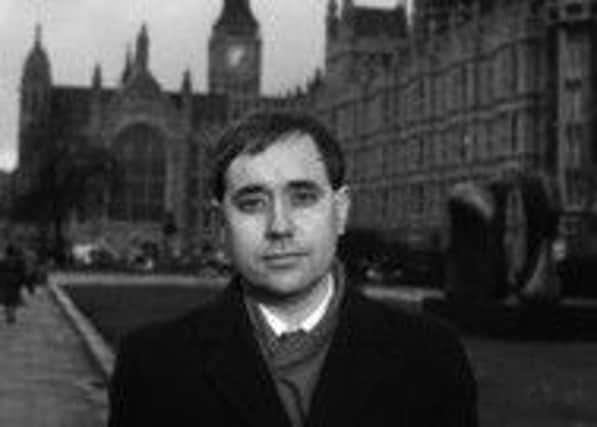Alex Salmond timeline: Rebel to First Minister


December 31 1954: Alexander Elliot Anderson Salmond is born in Linlithgow, West Lothian - the same town that was the birthplace of Mary Queen of Scots.
1973: Joins the SNP while a student at St Andrews University.
Advertisement
Hide AdAdvertisement
Hide AdJune 11 1987: Is elected to Westminster in the general election, winning the seat of Banff and Buchan from the Conservatives.
March 15 1988: Less than a year after being elected, Mr Salmond makes headlines when he disrupted then chancellor Nigel Lawson’s budget speech in the House of Commons. The incident resulted in him being suspended from the House for a week.
September 22 1990: Becomes leader of the SNP.
September 11 1997: A referendum to establish the new Scottish Parliament is held, with Mr Salmond and his SNP campaigning alongside Labour and the Liberal Democrats for a Yes vote.
March 29 1999: Mr Salmond becomes the first leading UK politician to speak out against air strikes against Serbia, describing them as “an act of dubious legality, but above all one of unpardonable folly”.
May 6 1999: As well as being the MP for Banff and Buchan, Mr Salmond is elected as MSP for the same constituency in the first elections to the devolved Scottish Parliament. He is leader of the opposition, with Labour joining forces with the Liberal Democrats in a coalition government.
July 17 2000: Mr Salmond announces he is to stand down as SNP leader to concentrate on Westminster. He is succeeded in the post by John Swinney.
May 14 2001: Mr Salmond leaves Holyrood, stepping down as an MSP.
June 2004: After Mr Swinney resigns as SNP leader, Mr Salmond says he has no intention of returning to the post, stating: “If nominated I’ll decline. If drafted I’ll defer. And if elected I’ll resign.”
Advertisement
Hide AdAdvertisement
Hide AdJuly 15 2004: Mr Salmond announces he will stand for leader, telling reporters: “I changed my mind.” At the same time Nicola Sturgeon, who had been a candidate for the party leadership, announces she is no longer contesting that job and wants to be Mr Salmond’s deputy.
September 3 2004: Mr Salmond is elected as SNP leader for the second time with a landslide victory. Ms Sturgeon is voted in as his deputy, marking the start of a political partnership that will last a decade.
May 3 2007: Mr Salmond is elected to Holyrood for a second time, winning the Gordon constituency. His SNP becomes the largest party in the Scottish Parliament by the narrowest of margins, winning 47 seats to Labour’s 46.
May 16 2007: Mr Salmond is elected as Scotland’s first SNP First Minister, leading a minority administration at Holyrood.
May 5 2011: Mr Salmond leads the SNP to a landslide victory in the Scottish Parliament elections, with the party taking 69 of the 129 seats. With elections to Holyrood determined by proportional representation, it is the first time any party has had an overall majority.
January 25 2012: Mr Salmond formally launches the Scottish Government’s consultation on plans to hold an independence referendum in a statement to Holyrood, promising the run-up to the ballot will be the “most exciting in Scotland’s modern history”.
October 15 2012: After talks between the UK and Scottish governments, Mr Salmond and Prime Minister David Cameron sign the Edinburgh Agreement, paving the way for a referendum on independence.
November 26 2013: Mr Salmond launches the Scottish Government’s 670-page White Paper on independence, hailing it as “a mission statement and a prospectus for the kind of country we should be”.
Advertisement
Hide AdAdvertisement
Hide AdSeptember 18 2014: Voters across Scotland go to the polls in the referendum, where they are asked “Should Scotland be an independent country?”. In the historic ballot, 45% vote Yes, with the majority (55%) opting to stay in the UK.
September 19 2014: Mr Salmond calls a press conference at his official residence, Bute House in Edinburgh, where he announces his intention to step down as SNP leader and First Minister.
November 14: Mr Salmond steps down as SNP leader at the party’s conference in Perth.
November 18: Mr Salmond gives a statement to Holyrood, formally resigning as First Minister.
SEE ALSO: